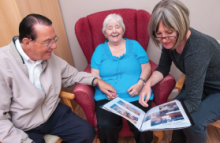Breadcrumb
Training Modules of Partnerships to Improve Care and Quality of Life for Persons with Dementia

Module 1: Introduction & Overview
The purpose of staff-family partnerships, main components of the Family Involvement in Care Intervention, and how training topics build on one another and overlap with the companion family training series are introduced and briefly reviewed.
Presentation (7:33) | Power Point Presentation - Module 1 | Handout - Family Involvement in Care Intervention

Module 2: Understanding Changing Needs
Understanding the progressive loss of abilities that leads to changing care needs can help staff and family find the best approaches to support function and well-being, and avoid problematic behaviors.
Presentation (14:43) | Power Point Presentation - Module 2 | Handout - NDB Model | Handout - Stages of Dementia

Module 3: Role Changes for Family members
Placing upset feelings or demands in the context of family-role stress can help staff respond, not react to strong emotions, and work to identify and solve the “real” problem experienced by family.
Presentation (13:36) | Power Point Presentation - Module 3 | Handout - Assessment Inventory

Module 4: Interacting with Family Members
Ways to listen with the intent of understanding the other person’s “real” problem, staying calm, and knowing when to direct issues to a supervisor are essential skills for building staff-family relationships.
Presentation (16:45) | Power Point Presentation - Module 4 | Provider Interview Clips (1:33)

Module 5: Family-Staff Partnerships: First Steps
Using the Family Involvement in Care Intervention starts by orienting family members to staff-family partnerships and assessing the needs of both family and their relative with dementia.
Presentation (16:19) | Power Point Presentation - Module 5 | Handout - Assessment Inventory | Handout - Orienting Families to Being Partners | Handout - Questions and Ideas for Family | Handout - Simple Pleasures Activity Options | Form - Partnership Agreement Form

Module 6: Family-Staff Partnerships: Part 2
Negotiation of the partnership agreement is an essential step that helps staff and family develop mutually satisfying care plans that fit the needs of the person with dementia, family, and staff alike.
Presentation (8:27) | Power Point Presentation - Module 6

Module 7: Family-Staff Partnership: Part 3
Conducting successful partnership agreement meetings is promoted by using basic ground rules and approaches, including when the agreement will be renegotiated, and how information will be gathered and shared.
Presentation (10:38) | Power Point Presentation - Module 7

Module 8: Person-Centered Care Overview
Understanding common characteristics of person-centered care can help staff caregivers identify and use approaches, practices, and routines that support being person-centered in daily care.
Presentation (9:48) | Power Point Presentation - Module 8

Module 9: Staying Person-Centered: Opportunities & Methods
Staying “person-first” in daily interactions and using family members as “guides” to behavior symptoms can help staff be person-centered, even when the person with dementia is not well known to the staff.
Presentation (14:57) | Power Point Presentation - Module 9 | Provider Interview Clips (1:32)

Module 10: Knowing the Person with Dementia
Traditional and novel ways that staff and family may collaborate to develop “life stories” to support person-centered care by identifying characteristics, values, or experiences that may guide daily interactions.
Presentation (11:14) | Power Point Presentation - Module 10 | Handout - Know My Preferences | Handout - My Life Story | Handout - My Top 5

Module 11: Goal-Directed Care: Identifying & Using Values to Direct Care Decisions
Early discussions and information-sharing with family related to goals of care may reduce stress and crisis-based decisions, and advance “person-centered” care and treatment decisions.
Presentation (14:23) | Power Point Presentation - Module 11 | Handout - Smart Plus | Handout - Stages of Dementia

Module 12: Hospice Approach to Dementia Care
The step-wise “hospice approach” to dementia care helps families plan ahead by discussing issues that are common in later-stage dementia and methods to best support their relative’s wishes.
Presentation (18:00) | Power Point Presentation - Module 12 | Handout - Common Sources of Burdensome Care | Handout - Form Guidance - IPOST | Handout - Hospice Approach to Dementia Care